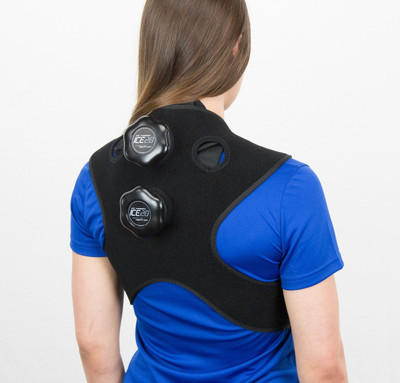 3rd Sep 2018
3rd Sep 2018
How to Treat Mid-Back Pain
While low back pain is the most common type, middle-back pain is just as uncomfortable, debilitating and becoming more prevalent with more and more people suffering from postural deficits. Fortunately, physical therapy and the applied use of specific modalities can help completely eradicate middle back pain and help reduce the risk of it recurring.
What is Middle-Back Pain?
Middle back pain specifically refers to pain or discomfort located in thee thoracic spine — the region of the back between the rib cage and the base of the neck. This is a large area that is comprised of 12 spinal disks, several vertebrae, and many muscles and ligaments. When any of these structures become irritated or damaged, this can lead to middle back pain which can also lead to loss of functional movement.
Symptoms of Mid-Back Pain
The most common symptoms associated with middle back pain are numbness, stiff muscles, or burning sensations.
Additional middle back pain symptoms may vary depending on the underlying cause of the pain.
Some common accompanying symptoms include:
- burning sensations
- dull or aching pain
- sharp or stabbing pain
- tight or stiff muscles
What Causes Middle Back Pain?
There are many possible causes of middle back pain, ranging from injury to poor posture.
Some of the most common type of mid-back pain include:
1. Aging
Back pain is one of the most common complains in patients over the age of 30. While back pain can be typical in patients aged 30-60, it can affect patients of any age. Some of the causes of mid-back include:
- less fluid between spinal joints
- reduced muscle mass
- thinning bones
2. Arthritis
There are more than 100 types of Arthritis, many of which can lead to mid-back pain. Some of the more typical types of Arthritis that cause pain in the thoracic spine include:
Osteoarthritis (OA) is a progressive type of arthritis that is a common degenerative joint disease that affects 30 million adults in the United States annually. Osteoarthritis causes the ends of bones to rub together, leading to pain, swelling, and stiffness.
Ankylosing spondylitis is another type of arthritis that can cause pain in the thoracic spine. In addition to pain and tenderness, patients may also experience debilitating stiffness in the back. Over time, the vertebrae will begin to fuse together, which can impact posture and mobility leading to loss of function and disability.
3. Herniated disks
Disks in the back are located between the vertebrae, where they act as shock-absorbing cushions and help a person move. When disks are healthy, they are filled with liquid to help improve this shock-absorber effect. However, the disks can rupture or bulge outward. This is known as a herniated disk, slipped disk, or ruptured disk, and it puts pressure on the surrounding nerves causing pain in the surrounding area. For some patients, a herniated disk in the mid-back does not always cause symptoms, but most patients may experience pain, tingling, or numbness in the thoracic spine.
4. Osteoporosis
Osteoporosis affects more than 54 million Americans. It is a type of bone disease that results in brittle bones that can lead to an increased risk of bone fractures. Osteoporosis occurs when the body does not make enough new bone to replace natural bone loss.
People with osteoporosis in the back can experience middle back pain due to strains or compression fractures in the vertebrae.
5. Poor posture
We are seeing a dramatic increase in pain and injuries that occur due to postural deficits. More and more people are spending their time hunched over a laptop or computer as well as an inordinate amount of time on their smart phones, most patients have difficulty maintaining neutral posture. Poor posture while sitting or standing is a leading cause of back pain. When a patient slouches, it increases pressure on the spine and leads to strained muscles as they try to maintain balance.
Read below to learn more about the different causes of middle back pain and the physical therapy techniques that help our patients find relief.
- 1.Ultrasound therapy: Ultrasound therapy is a non-invasive pain-relieving modality that can effectively reduce low-back pain without uncomfortable side effects.
- 2.Transcutaneous Electric Nerve Stimulation (TENS): TENS helps stop the pain reaction that is experienced in the mid-back. TENS sends an electrical current that travels through electrodes and into the skin stimulating specific nerve pathways to produce a tingling or massaging sensation that reduces the perception of pain.
- 3.Combination Device: An ultrasound therapy/electrical stimulation device marries the benefits of both modalities in one convenient device. This helps reduce treatment time and maximize therapeutic benefit.
- 4.Cold compression therapy: Cold compression therapy stops mid-back pain almost immediately. The cold provides effective analgesic benefits while compression helps to release any nerve impingement. Cold compression is offered in a convenient wrap that can adequately address the mid-back and shoulder region.
- 5.Therapeutic Exercise: Core work that focuses on working the abdominal and back muscles can help support the back at the same time it helps improve the patient’s ability to maintain a neutral posture. Not only will this help reduce pain, but it will decrease the likelihood of recurrence.
Contact us today!
We can help your practice find the perfect therapeutic therapy device or equipment to work with your patient who suffer from mid-back pain. Contact us today and we’ll answer any questions you may have about the benefits of all the products we offer! Call us today at 1-801-770-3328 for more information.






